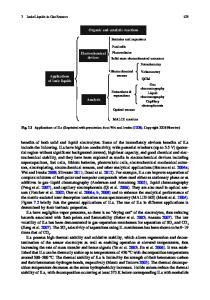Bimetallic Nanoparticles as Catalysts in Ionic Liquids
- PDF / 389,036 Bytes
- 6 Pages / 612 x 792 pts (letter) Page_size
- 8 Downloads / 387 Views
1082-Q04-02
Bimetallic Nanoparticles as Catalysts in Ionic Liquids Robert William James Scott, and Priyabrat Dash Department of Chemistry, University of Saskatchewan, 110 Science Place, Saskatoon, S7N 5C9, Canada ABSTRACT We will show that metallic and bimetallic nanoparticles solubilized in 1-butyl-3methylimidazolium hexafluorophosphate ionic liquids (IL) can be used as catalysts for a variety of oxidation and hydrogenation reactions. Nanoparticles were either directly synthesized in the IL or transferred to the IL from other solvents. Characterization was carried out by UV-Vis spectroscopy and transmission electron microscopy. Both the activity and selectivity of the hydrogenation reactions could be tuned by varying the composition of AuPd bimetallic nanoparticles. We will also show that the nanoparticle/IL catalysts can be recycled and then reused for further catalytic reactions with minimal loss in activity. In addition, new insights into the stabilization of nanoparticles in ionic liquids will be presented. INTRODUCTION Quasi-homogeneous catalysis utilizing nanoparticle catalysts stabilized in solution have attracted a great deal of research attention in the past 10 years.[1,2] Major challenges in this field involve finding methods in which to stabilize high-surface area nanoparticles in solution without passivating them, such that a large number of catalytic sites are still available on the surface. One interesting example of a successful system for such work has been the work of Dupont and coworkers, who have shown that nanoparticles can be solubilized in IL solvents, and that the resulting nanoparticles are stable and have significant catalytic activities for a wide range of hydrogenation reactions.[3,4] This work has taken advantage of the fact that the driving forces for nanoparticle aggregation in room temperature IL solvents is reported to be much lower given their low surface tensions.[5] However, several groups have pointed out that halide and water impurities in ILs could also be partially or fully responsible for nanoparticle stabilization.[6,7] Intrigued by this work, we wished to examine whether bimetallic AuPd nanoparticles are stable in IL solvents, and if so, whether the resulting catalytic activity of such particles could be maximized in the absence of stabilizers. Two routes were examined to solubilize AuPd nanoparticles in 1-butyl-3-methylimidazolium hexafluorophosphate, [BMIM][PF6] ILs; the first involved the transfer of poly-vinylpyrrolidone (PVP)-stabilized nanoparticles from methanol to the IL solvent, and the second involved the direct synthesis of AuPd nanoparticles in the IL solvent. Both methods were successful, however, we found that low levels of 1-methylimidazole additives were necessary to stabilize nanoparticles directly synthesized in ionic liquids during catalytic hydrogenation reactions, while PVP-stabilized particles were quite active and stable in the IL solvent. Finally, we show that PVP-stabilized 1:3 Au:Pd bimetallic nanoparticles have significantly higher hydrogenation
Data Loading...











